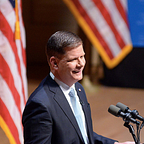A historically diverse police academy class reflects Boston’s neighborhoods
Last month, I spoke at the graduation ceremony for the Boston Police Academy’s newest recruits. These men and women had spent the last six months learning to serve and protect the people of Boston with the highest standards of excellence and professionalism. As each recruit crossed the stage, they stopped to shake hands with me and Commissioner Gross. It was a powerful experience meeting each and every new member of our city’s police department, which is the oldest, and I can proudly call the best, in the nation.
Many of the recruits had their families accompany them as they received their badges. Recruits were joined by their mothers, their husbands, their children and their friends, many with tears in their eyes. All of them exuded a deep sense of pride as they watched their loved ones receive their badges and begin their careers as Boston Police Officers.
A large number of these new officers were born and raised right here in Boston. Today all of them call Boston their home. And they bring a wide array of experience. Among them are veterans, former teachers and youth sports coaches. It was a powerful reminder of the deep connections our police officers share with our community.
This graduating class also reflects Boston’s rich diversity of languages, cultures, backgrounds, and religions. It includes more women and more people of color than any class in recent memory. 21 of the graduates went through the Boston Police Cadet program. This is the largest group of former cadets to graduate from the academy since we reinstated the cadet program in 2015.
The cadet program is a paid, on-the-job training program for young people in Boston’s neighborhoods. It prepares them for the rigors of the Police Academy, and connects a more diverse pool of candidates with local careers in law enforcement. The original Boston Police Cadet program ran from 1978 until 2009, and produced some of BPD’s finest, including Commissioner William Gross, former Commissioner Billy Evans, and Superintendent Lisa Holmes.
When I was elected Mayor, I made it a priority to reinstate the cadet program. I saw it as a powerful way to make our police department more representative of the people it serves. In the four years since we brought the cadet program back, the results have spoken for themselves.
63% of cadets have been people of color, representing Boston’s black, Latino, Asian, and Native American communities. The percentage of female cadets has steadily increased, and the current 2019 cohort of cadets is exactly 50% female. To see how significant these numbers are, take a look at the national landscape. Throughout the United States, about 25% of police officers are people of color, and about 15% are women. The Boston Cadet program is pushing doors wide open for a much more diverse, more inclusive police department in Boston.
A diverse police force is crucial to our public safety strategy. It helps ensure that our men and women in uniform deeply understand the challenges people are facing in our neighborhoods. It helps ensure that they’re well-equipped to address these challenges in a way that leads to lasting, positive change. It also helps build trust between our police and the people they serve, so that residents feel safe coming forward and asking for help during emergencies.
At a time when community-police relations are an issue across the country, the Boston Police have set the highest standard for professionalism, respect, and building trust in the community. Our police do this work every single day. Whether it’s patrolling a neighborhood, talking with residents at community events, or playing a game of basketball with our youth.
Our police officers are trusted and familiar faces in our neighborhoods. They’re not just responding to emergencies. They are an important part of a support system for our communities — working with public health, social service, and youth work professionals.
This is what community policing looks like, and it has helped make Boston one of the safest cities in America. Our crime rate has fallen by roughly 25% over the last 5 years. This year alone, major crime is down by about 10%. At the same time, we’ve arrested far fewer people. Our motto is that we keep Boston safe by “lifting people up, not locking people up.”
Diversifying and strengthening the Boston Police Department is part of a broader, citywide commitment. We’re working with the State to create a cadet program for the Boston Fire Department. And through our CityAcademy hiring initiative and improved outreach, we’re drawing from a more diverse candidate pool for EMT’s and paramedics, as well. This commitment extends beyond public safety and first responders — it’s about every part of city government. My cabinet is the most diverse in the history of our city, and nearly half of all full-time city employees hired over the last five years have been people of color.
This work is about making sure we’re serving the people of Boston the best way we possibly can. We’re making sure everyone who loves our city and wants to make it better has the opportunity to serve it. We’re breaking down the systemic barriers that have historically held women and communities of color back. And we’re building a culture of trust and resilience across all our neighborhoods.
The former cadets who graduated last week are now part of a long and proud tradition of excellence in Boston, and they will build on the progress we’ve made. We will rely on them to improve the way we work with our communities and recover from crises. We will replicate the success of the cadet program and continue to push doors wide open for everyone who wants to serve our city.
